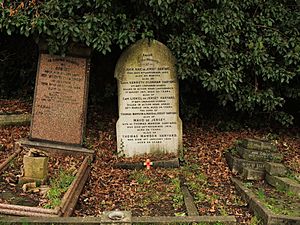Brockley and Ladywell Cemeteries facts for kids
| Details | |
|---|---|
| Established | 1858 |
| Location | |
| Country | England |
| Size | 37 acres (15 ha) |
Brockley and Ladywell Cemeteries are two old cemeteries in London, England. They opened in 1858, very close to each other. These cemeteries are great examples of early Victorian public burial grounds. Today, they are part of the Brockley Conservation Area.
These cemeteries cover about 37 acres of land in the London Borough of Lewisham. The local council owns and manages them. They are also important places for nature, full of wildlife, plants, and wildflowers.
For a long time, until 1948, a wall separated the two cemeteries. Ladywell Cemetery was once called Lewisham Cemetery. It is on the east side of the wall. Brockley Cemetery, previously Deptford Cemetery, is on the west. Both places hold many interesting historical stories. You can find clues about Deptford's past as a seafaring town on the old headstones.
Contents
Who is Buried Here?
Many interesting people are buried in Brockley and Ladywell Cemeteries. Here are some of them:
- Joseph Henry Blackburne (1841–1924): A famous English chess player from the late 1800s.
- Commander Archibald Walter Buckle (1889-1927): A military leader in World War I.
- Horatio Henry Couldery (1832–1918): A well-known Victorian artist who painted animals.
- Jane Clouson (1854–1871): A young girl whose monument was paid for by public donations.
- Ernest Dowson (1867–1900): A poet and artist.
- Sir William Eames (1821–1897): An important marine engineer.
- Sir John Gilbert (1817–1897): An illustrator for famous newspapers like the Illustrated London News and Punch.
- Sir George Grove (1820–1900): The first director of the Royal College of Music and author of a famous music dictionary.
- Sir William Hardy (1807–1887): A keeper of public records.
- Lionel de Jersey Harvard: A special person remembered here, known as "the only Harvard to attend Harvard." He died in World War I.
- George Lacy Hillier (1856–1941): An English racing cyclist and a pioneer in British cycling.
- David Jones (1895–1974): A war poet and artist.
- Fernando Tarrida del Mármol (1861–1915): A Cuban writer.
- Margaret McMillan (1860–1931): An important person who worked to improve education.
- Sir Alexander Nisbet (1812–1892): An Inspector General of the Royal Navy and a doctor to the Queen.
- William Stephens (1817–1871): A leader in the Grand Lodge of England.
- E. H. Windred (1875–1953): A painter known for his pictures of racing pigeons.
- Edward Lewis (1864–1922): An actor and comedian.
- Joe Bowker (1881–1955): An English boxer who was a world champion in 1904 and 1905.
- Samuel Tinsley (1847–1903): An English chess player.
- Mary Ann Bevan (1874–1933): A woman known for her unique appearance.
War Graves: Remembering Heroes
Both cemeteries have special sections for Commonwealth service personnel who died in wars. These graves are cared for by the Commonwealth War Graves Commission (CWGC).
Brockley Cemetery War Graves
Brockley Cemetery has 195 war graves. Most of these are from World War I (175 graves) and 19 are from World War II. Many of these graves are together in a special War Plot. On the west side of the cemetery, there is a Screen Wall memorial. It lists the names of those whose graves could not have a headstone.
Ladywell Cemetery War Graves
Ladywell Cemetery has 226 war graves from World War I and 18 from World War II. A War Graves plot here holds 100 graves. The names of those buried there are listed on a Screen War Memorial. This memorial also lists others buried in the cemetery whose graves don't have headstones. The CWGC also looks after a Commemorative Plot with 46 headstones.
Ladywell Entrance Gates
The main entrance gates to Ladywell Cemetery are very old and important. They are listed as a Grade II building. This means they are historically significant. The gates were built in 1857. William Morphrew designed them for the Lewisham Burial Board.
The gates are made of strong wrought iron. The stone pillars are square with sloped tops. The gates have a fancy Gothic design. You can see the initials of the Lewisham Burial Board on them. The name "LADYWELL CEMETERY" might have been added later, or it could be a new version of the original name, "LEWISHAM CEMETERY." However, the style of the letters clearly shows they were made in 1857.
Images for kids




